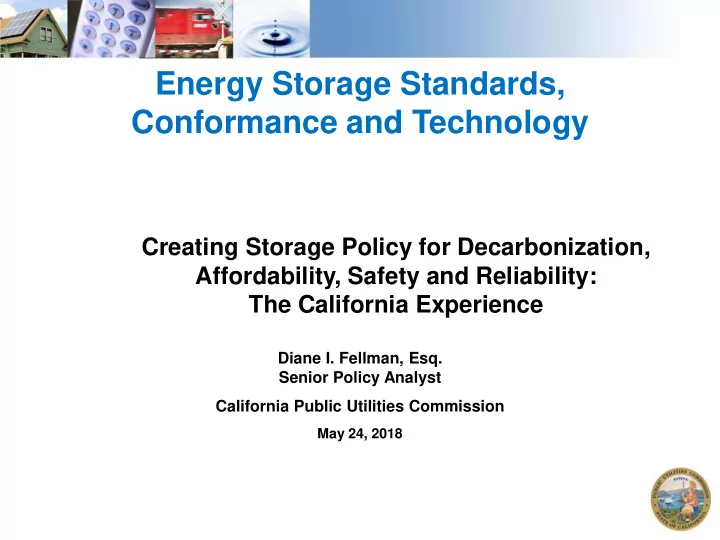

Energy Storage Standards, Conformance and Technology Creating Storage Policy for Decarbonization, Affordability, Safety and Reliability: The California Experience Diane I. Fellman, Esq. Senior Policy Analyst California Public Utilities Commission May 24, 2018 1
Disclaimer This presentation was prepared by California Public Utilities Commission (CPUC) staff. It does not necessarily represent the views of the CPUC, its Commissioners, or the State of California. The CPUC, the State of California, its employees, contractors, and subcontractors make no warrant, express or implied, and assume no legal liability for the information in this presentation. It has not been approved or disapproved by the CPUC, nor has the CPUC passed upon the accuracy or adequacy of the information in it. 2
California Statistics Population: 39,500,000 (1 st in US) Kenya: 49,125,325 Area: 163,696 sq. mi. Kenya: 224,080 5 th Largest Global Economy Diversity of Natural Resources Statewide peak demand: ~ 76,500 MWs Kenya: 2336 MWs installed 3
Federal v. California CPUC • Independently owned utilities • Retail electric rates • Generation planning and FERC procurement • Distribution infrastructure investment • Electric transmission and wholesale rates • Power plant siting approvals CEC and services Thermal >50 MW • • Hydroelectric • Appliance and Building Efficiency dam licensing and Standards safety • Demand Forecasting • Natural gas • Investing in Energy Innovation pipeline • Transforming Transportation transportation rates and services CAISO • Reliability – Grid • Manages the flow of operators electricity across the high- voltage, long-distance power transmission lines • Operates a competitive wholesale power market
California Energy Policy Foundations Safety Affordability Consumer Protection Reliability & Resiliency Just and Reasonable Rates Equitable Decarbonization Access to Services 5
California’s Policy Goals: Details • 50% of retail energy from renewable power by 2030 • Greenhouse Gas Emissions Reduction to • 40% below 1990 levels by 2030 • 80% below 1990 levels by 2050 • Shut down powerplants using coastal water for cooling • Increased distributed generation, including storage • 5 million zero emission vehicles by 2030 6
Success of California’s Policies Reduce GHG emissions while growing the economy and… 7 Source: 2017 California Integrated Energy Policy Report (IEPR), CEC
Success of California’s Policies Per capita electricity use stayed flat while increasing nationally 8 2017 California Integrated Energy Policy Report (IEPR), CEC
Renewables* Penetration in California *Does not include large hydro or nuclear Source: CAISO What are we doing to green the grid? 9
Challenges to the Grid from Renewables This is the Duck Curve: High Ramps due to Renewables Actual Renewables Output: Tuesday, May 15, 2018 10
Storage Mitigates Grid Impacts: Resilient Reliable Efficient Ratepayer Costs must be considered 11 Source: California Energy Storage Alliance – Storage 101
California Storage Policy Approaches • Legislation • Mandated Procurement Statutes • Technology Neutral & Diversity of Size Mandates • Priority over fossil fuels for grid resiliency • BTM*: Self-Generation Incentive Program • Interconnection Incentives • Resource in Wholesale Markets Processes • Rate design: Time of Use; Net Metering • Long-term Contracting • Multiple Use Applications: Storage/Solar Expanded • Ancillary Services and Load Shifting Revenue • Integrate Renewables *Behind the Meter 12 Detailed References Provided on Last Slide
California Storage Policy Barriers • Storage costs exceeded other resources for all applications Cost • Technologies are under development and have not yet gone to scale • Applications may not match grid needs Technology e.g. duration • Procurement process and permitting may cause delays Timing *Behind the Meter 13 Detailed References Provided on Last Slide
Storage Technologies in California 14
Growth of Storage in California Text goes here 15
Conclusion: Where does storage belong? All of the above: 16 Source: Pacific Gas & Electric Company
Under2 MOU: Climate Initiative Under2 MOU is a commitment by sub-national governments to reduce their GHG emissions by 80-95% on 1990 levels or to 2 metric tons of carbon dioxide- equivalent per capita, by 2050. Laikipia County, Kenya is a signatory and working on land management practices 17
References Advancing and Maximizing the Value of Energy Storage Technology: A California Roadmap (2014) California Public Utilities Commission (CPUC), California Energy Commission (CEC) and California Independent System Operator (CAISO), CPUC Energy Storage Webpage includes links to: AB 2514 (Skinner, 2010) Legislation directing CPUC to create a storage procurement Mandate Rulemaking 15-03-011 CPUC storage proceeding that developed procurement targets for 1,325 MWs Rule 21 Interconnection proceeding to promote grid interconnection of storage Storage Roadmap Implementation of Joint Agency storage protocols (see link above) Reference Documents Self Generation Incentive Program ( SGIP) SGIP provides rebates for storage facilities on the customer side of the meter Aliso Canyon Install 98.5 MW of storage to offset natural gas usage due to leakage at natural gas field Tracking Storage Progress in California CEC Tracking Progress: Energy Storage (2008-2017) CAISO: Renewables and emissions reports Governor Brown: Climate Investments Executive Order January, 2018 Under2mou.org California Energy Storage Alliance Storage Trade Association comprised of storage companies 18
Kenya Energy Statistics Source : Ministry of Energy 19
Thank you! For Additional Information: www.cpuc.ca.gov diane.fellman@cpuc.ca.gov 20
Recommend
More recommend